German Sieht Amethyst besser mit Gold oder Silber aus?

Wenn Sie die perfekte Fassung für Amethyst wählen, ist die Debatte zwischen Gold und Sterlingsilber so zeitlos wie der Schmuck selbst. Amethyst ist ein Edelstein mit violettem Farbton, der Eleganz und Raffinesse ausstrahlt. Verschiedene Metalle vermitteln unterschiedliche Gefühle, und natürlich variieren auch die Preise. Lassen Sie uns das gemeinsam im Artikel erkunden.
1. Wissen Sie etwas über Amethyst?
Die Farbe und Eigenschaften von Amethyst
Amethyst, eine Form von Quarz, wird für seine auffälligen violetten Schattierungen geschätzt, die von blassem Flieder bis zu sattem Violett reichen. Die Menge an Eisen und anderen Spurenelementen im Stein beeinflusst diese Farbvariation. Mit einer Härte von 7 auf der Mohs-Skala ist Amethyst robust genug für den regelmäßigen Schmuckgebrauch, kann aber dennoch zerkratzt werden, wenn man nicht vorsichtig damit umgeht. Er hat außerdem eine Dichte zwischen 2,65 und 2,91 sowie einen Brechungsindex von 1,544 bis 1,553, was zu seinem Glanz und seiner Brillanz beiträgt.
Historische Bedeutung und Verwendung im Schmuck
Amethyst hat im Laufe der Geschichte einen besonderen Platz eingenommen, oft mit Königtum verbunden und prominent in Kronen, Ringen und religiösen Objekten vertreten. Die alten Griechen glaubten, er habe schützende Eigenschaften gegen Trunkenheit, sein Name stammt vom griechischen Wort "amethystos", was "nicht betrunken" bedeutet. In verschiedenen Kulturen war Amethyst ein Symbol für Macht und Reinheit. Seine Beliebtheit erreichte während der Renaissance neue Höhen, als er häufig in feinem Schmuck der europäischen Aristokratie verwendet wurde.
Variationen im Farbton und in der Klarheit von Amethyst
Die Farbe des Amethysts kann je nach Fundort variieren. Zum Beispiel wird sibirischer Amethyst für seinen tiefen violetten Farbton mit roten und blauen Nuancen geschätzt, was ihn sehr begehrt macht. Brasilianischer Amethyst hingegen hat oft einen helleren, transparenteren Violettton, was ihn oft budgetfreundlicher macht. Amethyste sind typischerweise recht klar, die meisten sind frei von sichtbaren Einschlüsse. Gelegentlich sieht man Farbzonierungen, bei denen verschiedene Violettschattierungen im selben Kristall erscheinen, was seinen einzigartigen Charme verstärkt.
2. Gold vs. Silber: Eigenschaften und Anziehungskraft
Die ästhetischen Qualitäten von Gold
Gold ist bekannt für seinen warmen, reichen Glanz und ist in verschiedenen Farbtönen wie Gelb-, Weiß- und Roségold erhältlich. Gelbgold mit seiner zeitlosen, tiefen Farbe wird oft mit Luxus und Tradition assoziiert. Üblicherweise enthält eine 18-karätige Legierung etwa 75 % Gold, gemischt mit Metallen wie Kupfer und Silber zur Erhöhung der Haltbarkeit. Roségold hat dank eines höheren Kupferanteils einen charakteristischen rosa Farbton und ist eine beliebte Wahl in zeitgenössischem Schmuck. Die reflektierende Natur von Gold verstärkt auch die Brillanz von Edelsteinen, wodurch diese noch lebendiger und faszinierender wirken.
Die ästhetischen Qualitäten von Silber
Silber besticht durch sein kühles, elegantes Aussehen und einen hellen, spiegelähnlichen Glanz, der oft wegen seines modernen und vielseitigen Stils gewählt wird. Die am häufigsten vorkommende Form ist Sterlingsilber, das aus 92,5 % reinem Silber und 7,5 % anderen Metallen – meist Kupfer – besteht, um die Haltbarkeit zu verbessern. Dank seines neutralen Tons passt Silber wunderbar zu verschiedenen Hauttönen und Edelsteinen und ist sowohl für den Alltag als auch für formelleren Schmuck beliebt. Sein glänzender Schimmer kann Edelsteine dezent hervorheben und verleiht eine zurückhaltende Eleganz, die perfekt zu minimalistischen Designs passt.
Haltbarkeits- und Trageeigenschaften
Gold ist tendenziell haltbarer als Silber, besonders bei höheren Karatstufen. Zum Beispiel ist 18-karätiges Gold nicht nur widerstandsfähiger gegen Anlaufen und Korrosion aufgrund seines höheren Goldgehalts, sondern löst auch seltener allergische Reaktionen aus. Sterlingsilber ist zwar recht robust, neigt aber im Laufe der Zeit eher zum Anlaufen und benötigt daher regelmäßiges Polieren, um seinen Glanz zu bewahren. Beide Metalle sind relativ pflegeleicht, erfordern jedoch unterschiedliche Pflege – Gold braucht vielleicht nur gelegentliches Polieren, während Silber oft von Anti-Anlauf-Behandlungen profitiert. In Bezug auf die Härte liegt Gold zwischen 2,5 und 3 auf der Mohs-Skala, während Sterlingsilber leicht höher bei etwa 2,5 bis 3 liegt.

3. Kombination von Amethyst mit Gold
Farbharmonie und Kontrast mit Gold
Das tiefe Violett des Amethysts bildet einen atemberaubenden Kontrast zu den warmen, goldenen Tönen von Gelbgold. Diese Kombination ist optisch fesselnd, da die Reichhaltigkeit von Gold die Lebendigkeit des Amethysts verstärkt und den Edelstein noch intensiver und luxuriöser erscheinen lässt. Die Harmonie zwischen Violett und Gelb, die sich im Farbkreis als Komplementärfarben gegenüberstehen, verstärkt diese Ästhetik und erzielt einen Look, der sowohl ausgewogen als auch auffällig ist. Wenn Amethyst in Gelb- oder Roségold gefasst wird, hebt dies oft die roten Untertöne des Steins hervor und verleiht seiner Farbe Tiefe und Komplexität.
Golds Einfluss auf das Erscheinungsbild von Amethyst
Die reflektierenden Eigenschaften von Gold können die Anziehungskraft von Amethyst erheblich steigern. In Gelbgold gefasst, nimmt die Farbe des Steins einen wärmeren und lebendigeren Ton an, was besonders bei dunkleren oder intensiver gefärbten Amethysten ansprechend ist. Die polierte Oberfläche der Goldfassung reflektiert Licht auf den Amethyst und verstärkt dessen Brillanz, wodurch er größer und auffälliger wirkt. Dieser Effekt ist besonders ausgeprägt bei höherkarätigem Gold, dessen höherer Goldanteil eine massivere Fassung bietet und die Gesamtwirkung des Schmuckstücks weiter erhöht.
Beliebte Gold-Amethyst-Schmuckstile
Amethyst ist eine beliebte Wahl in verschiedenen Goldschmuck-Designs, die die einzigartige Anziehungskraft des Edelsteins auf unterschiedliche Weise präsentieren. In vintage-inspirierten Stücken begleitet Amethyst oft filigrane Goldornamente, die einen königlichen und zeitlosen Charme hervorrufen. Zeitgenössische Designs zeigen Amethyst in schlanken, minimalistischen Goldringen oder Zargenfassungen, bei denen die natürliche Schönheit des Steins im Vordergrund steht. Amethyst-Cocktailringe in Gelb- oder Roségold sind besonders begehrt, mit großen, facettierten Steinen, die als auffällige Statement-Stücke hervorstechen. Außerdem sind Amethyst-Anhänger und Ohrringe in Goldfassungen für ihre Vielseitigkeit und Eleganz sehr geschätzt.





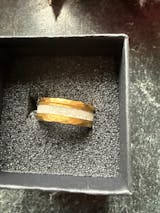
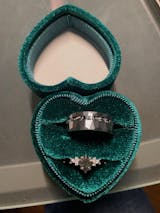
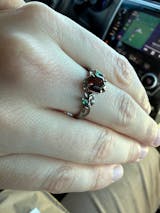
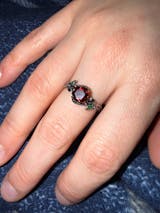
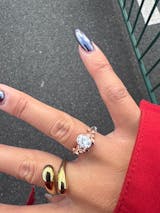

Hinterlassen Sie einen Kommentar